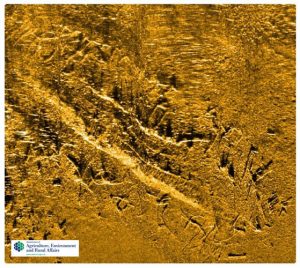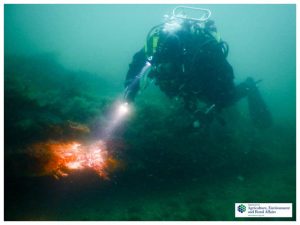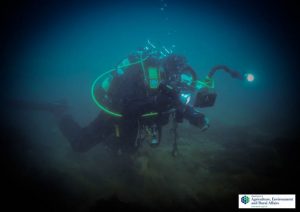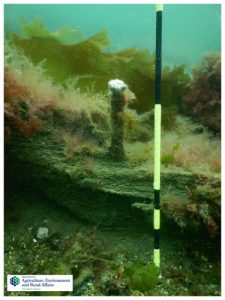From Portaferry head north along the Lough Shore Road for 1.2 miles and park on the lay-by at the side of the road where the road bends (leaving space for traffic). The entry point is from the shore beneath this lay-by.
Parking is off road and limited with no toilets nearby. The nearest public toilets are at Castle Park in Portaferry and the nearest tank filling facility is at DV Diving, Newtownards.
After low water the tide turns and currents make exiting more challenging.
A sand and gravel slope leads out to the wreck from 1-12 metres. The wreckage is partially covered in sediment.
Date of loss uncertain (poss. Feb/March 1850). The ‘Pins’ wreck is generally thought to be that of the two-masted schooner, Nimble, built in Penzance in 1836 (although it is sometimes also attributed as the Zarina). The Nimble was en route from Glasgow to Dublin under Captain Savage with a general cargo. She took fire in Ballyhenry Bay and was a total loss. The ‘Pins’ nickname originated from the fact that many copper/brass pins/bolts were to be seen at the wreck. Sadly not the case presently as many have been taken over the years as souvenirs or for their salvage value. In June 1995, the Irish Underwater Archaeology Research Team (IUART) carried out a survey of the vessel producing a full plan of the vessel. This plan was later published (see Breen 1996). Marine scientists and archaeologists from the DAERA and DfC carried out a side-scan sonar survey in 2017 and a dive inspection in 2018. They noted a predominance of iron knees in and around the site and copper or muntz metal sheathing along the port side of the vessel. The remains of the wreck include the timber keelson, stern-post, framing and floor timbers and a scattering of iron fittings. A re-evaluation of the wreck is needed and an examination of the typology of these features might lead to a closer dating of the vessel and its identification.
(Sources: Breen 1996; CSP 1852-53 Vol. 98 p.398; WA B57). CSP (Commons Sessional Papers); WA (Wilson Archive)
Information derived from Historic Environment Record of Northern Ireland (HERoNI), Department for Communities, Historic Environment Division.
Patches of sugar kelp Saccharina latissima and mixed red algae are growing on the wreck. The orange sea sponge Suberites ficus has been recorded here and a variety of starfish species (including brittlestars which may be found on the sand that coats the wreck).
View all species records from this site
A link to the dive site location on the NBN Atlas Northern Ireland website, showing all species records from within a 1km boundary of the site centroid. Any new species records from the site submitted to Seasearch, iRecord, CEDaR Online Recording or iNaturalist will appear hereStrangford Lough MCZ
Strangford Lough SAC
Strangford Lough SPA
Strangford Lough RAMSAR
Irish Wrecks Online – S.V. Nimble
Strangford Lough Regulation of Anchoring, Mooring and Diving Byelaws 2012
- In an emergency call 999 or 112 and ask for the coastguard.
- Follow VHF radio Channel 16 (156.8 MHz), the international distress frequency.
- Find nearest defibrillator (AED) here























Leave a Comment
Dived here recently? Then let other divers know about this site from your experience!